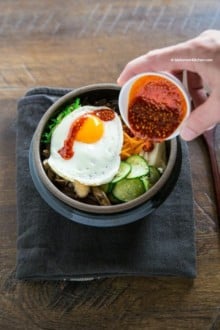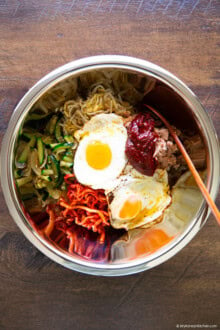Bibim Naengmyeon (Spicy Cold Noodles) is the perfect way to beat the summer heat! This flavor-packed dish has it all – icy chill, fiery spice, tantalizing sweetness, and zesty tang. Everything you need is in one bowl, making it a refreshing and satisfying meal. Get ready to dive into a bowl of pure bliss!

What is Bibim Naengmyeon
Bibim Naengmyeon (비빔냉면), which translates to “cold mixed noodles” in English, is a delightful and refreshing Korean dish perfect for warm weather. While the word “bibim” often connotes spiciness, as in bibimbap (Korean mixed rice), it’s essential to note that it’s not always the case.
This flavorful dish features cold, chewy noodles mixed with a vibrant sauce that’s spicy, sweet, and tangy. Topped with crisp veggies such as cucumber and radish pickles, along with sweet, juicy, and crispy Asian pear, boiled egg, and sliced beef, this dish is the ultimate summertime refresher.
Occasionally, it’s served with crushed ice made from beef broth, adding an extra layer of coolness to the dish. Trust me, you’ll forget all about the summer heat while indulging in these scrumptious noodles!
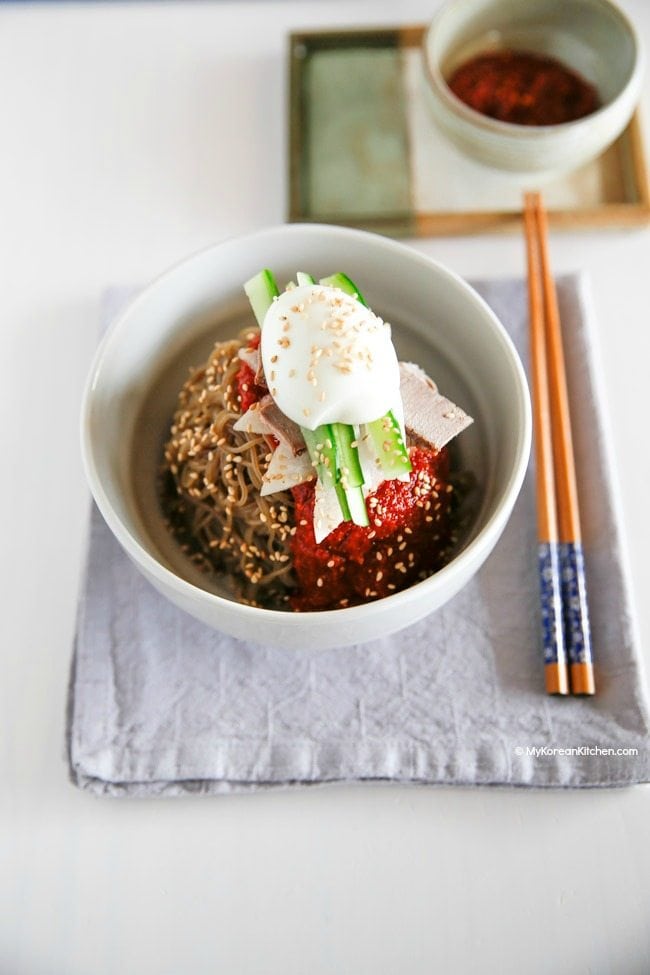
Bibim Naengmyeon vs. Mul Naengmyeon
Did you know that Bibim Naengmyeon has an equally fascinating twin sibling? It goes by the name Mul Naengmyeon (물냉면)!
As I explained earlier, Bibim Naengmyeon is a spicy dish with chewy noodles, gochujang sauce, fresh vegetables, cucumber, radish, and boiled egg. It’s perfect for those who love bold flavors and a bit of heat.
In contrast, Mul Naengmyeon offers a refreshing experience with the same chewy noodles served in an icy broth made from beef or radish water kimchi, garnished with julienned vegetables, Korean pear, and a boiled egg. This noodle dish is not spicy unless you decide to throw in some spicy sauce.
Naengmyeon and Korean BBQ
There’s no denying that summertime calls for refreshing dishes like Bibim Naengmyeon, but did you know another prime occasion to enjoy this vibrant dish is after indulging in Korean Charcoal BBQ at a restaurant?
Imagine savoring the last bits of succulent chargrilled meat in a smoky yet delightful room. What better way to conclude your Korean BBQ experience than with a plate of Bibim Naengmyeon, right?
Many Korean restaurants take great pride in their dishes, often serving sauce and broth that have been carefully brewed for days to ensure maximum flavor and deliciousness.
Well, guess what? I’m confident that my recipe can rival those served in restaurants! 😉 I hope you enjoy making it and find relief from the summer heat and humidity. Be sure to check out the essential tips and notes I’ve included near the end to elevate your Bibim Naengmyeon experience. Don’t miss them!

Other Korean Summer Noodle Recipes
I absolutely adore summer noodles, and I’m thrilled to share a few more delightful Korean cold noodle dishes that are perfect for the warm season! Don’t forget to explore these mouth-watering recipes by clicking on the dish names below. Enjoy!
- Spicy Cold Kimchi Noodles
- Jjolmyeon (Korean Spicy Chewy Noodles)
- Bibim Guksu (Korean Cold Noodle Salad)
- Jaengban Guksu (Spicy Noodle Salad Platter)
- Cold Soba Noodles (Cold Soba Noodles with Perilla Oil Dressing)
Ingredients for Bibim Naengmyeon (2 to 3 servings)
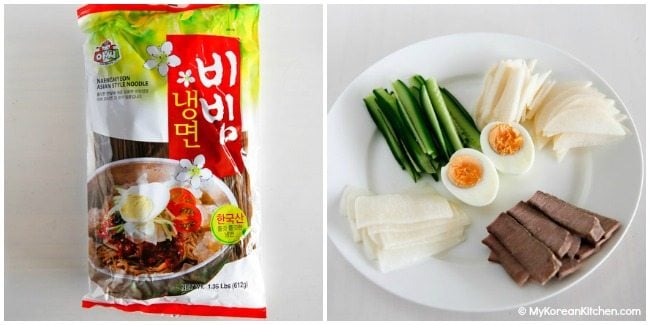
Main
- 350g/12.3 ounces dried naengmyeon noodles (Korean buckwheat noodles)
- 150g/5.3 ounces beef brisket (*see note)
- 5 cups water (*see note)
- 50g/1.8 ounces Korean radish (or daikon, pink radish), thinly sliced or julienned
- 50g/1.8 ounces Asian pear (or Bosc pear), thinly sliced or julienned
- 60g/2.1 ounces English cucumber, seeds removed, thinly sliced or julienned
- 1 hard boiled egg, halved
- 1 Tbsp roasted sesame seeds
- A dash of sesame oil
Bibim Sauce
- 20g/0.7 ounces Asian pear
- 20g/0.7 ounces brown onion
- 1/4 cup reserved beef broth (from step 1 below) or water (*see note)
- 3 Tbsp Korean chili flakes (gochugaru)
- 2 Tbsp raw sugar
- 1 Tbsp roasted sesame seeds
- 1 Tbsp Korean chili paste (gochujang)
- 1 Tbsp soy sauce
- 1 Tbsp apple vinegar
- 1 Tbsp minced garlic
- 1 tsp sesame oil
- 1 tsp fine sea salt
Radish Pickle Sauce (mix these together and microwave it for 30 to 40 seconds to melt the sugar)
- 2 Tbsp white sugar
- 3 Tbsp apple vinegar
- 2 Tbsp water
* 1 Tbsp = 15 ml, 1 Cup = 250ml
** If you want to learn more about Korean ingredients, check my Korean cooking ingredients list!
How to Make Bibim Naengmyeon
1. Soak the brisket in a bowl of water and set aside for 20 mins to draw the blood out. Drain the water. Add the water (5 cups) and the brisket into a medium to large pot, cover with the lid and boil them over high heat. Skim off any scum that forms. Once the water starts to rolling boil, reduce the heat to low-medium. Simmer until the brisket is tender and cooked (I boiled them for 1 hour total. This should result in about 3 cups of broth.) Take out the meat onto a plate. Cool down the meat and the broth for 30 mins. Cut off any stringy fat and thinly slice the brisket.
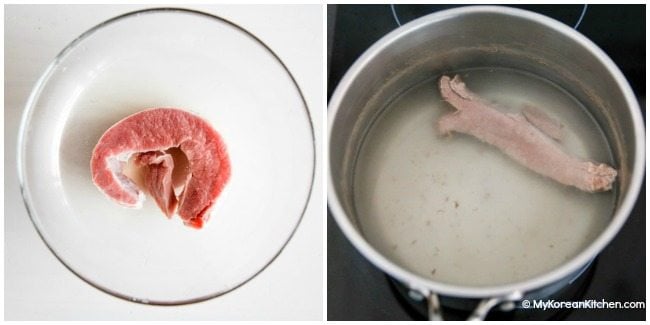
2. Soak the radish in the radish pickle sauce. Set aside until the radish is softened (about 20 mins). Cover and refrigerate until you need them. FYI, the longer you pickle, the less bitter the radish becomes.
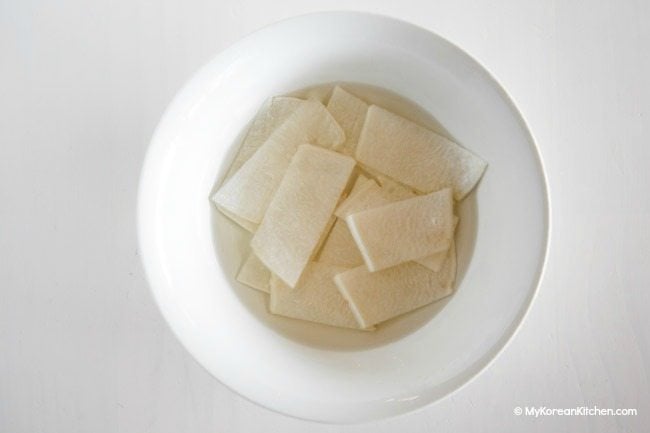
3. Combine all the bibim sauce ingredients and blend until pureed. Cover and refrigerate until needed.

4. Cook the noodles in boiling water until softened (about 2 to 3 mins). Stir often during boiling. The noodle texture should be chewy and bouncy. Drain the water and rinse the noodles under cold running water a couple of times to cool down. Drain the water quickly and divide the noodle portions for serving. Place the mound of noodles into a serving bowl.
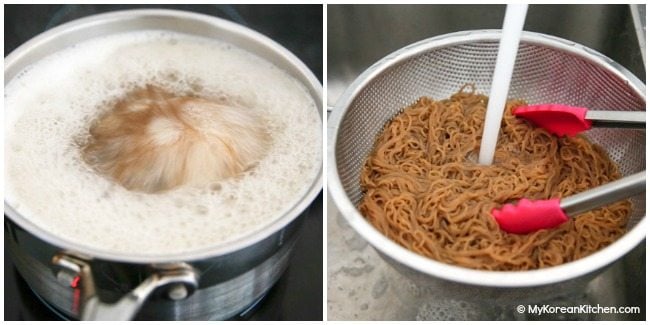
5. Place the sliced beef, radish pickles, cucumber, pear and boiled egg on top of the noodles. Add the bibim sauce on top. Drizzle some sesame oil and sparingly sprinkle roasted sesame seeds. (Refer above pictures for decoration ideas.) Serve immediately.
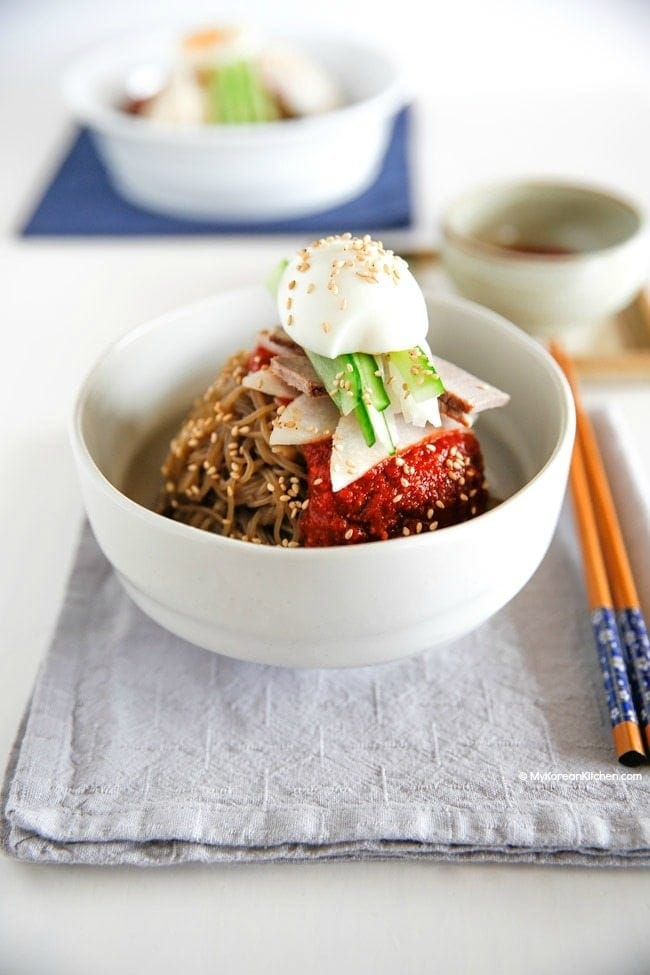
Tips – How to Eat Bibim Naengmyeon
- Cut through the noodles with kitchen scissors a couple of times to make them easier to mix and eat.
- If you want to dilute the spiciness or want to give some moisture to the noodles when you eat, you can pour in some reserved beef broth from step 1. This broth can be added in cold or warm. You can even freeze this broth in ice cube trays and eat the noodles extra cold!
- At a restaurant, they have yellow mustard paste and vinegar on standby at the table. If you want an extra spice kick or zing, you can add a small spoonful of these on the noodles.
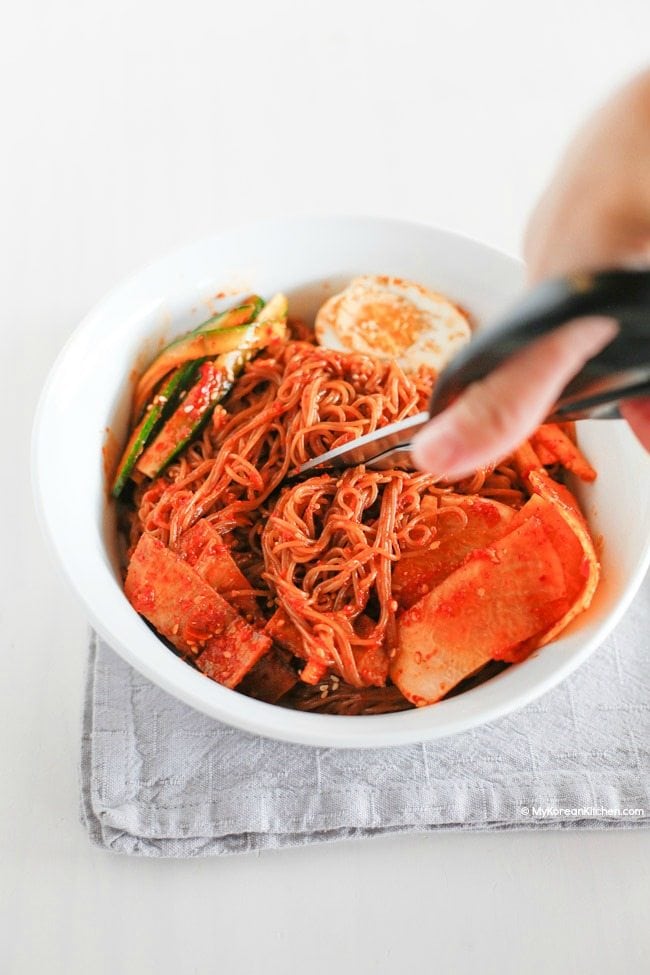
Note
- Step 1 to 3 can be done ahead of time (i.e. a day before noodle assembly). This helps develop more flavour in the sauce and keep them chilled longer. Also, it makes the workload “seem lighter” as the work is done over 2 days.
- A classic version of bibim naengmyeon sauce is made with beef brisket broth or bone broth. However if you have a particular dietary requirement, you can skip the meat/broth together. Just use water. Though I find that sauce made with broth gives more depth of flavour and it is less spicy than the sauce made with water.
- Any leftover broth can be used for other Korean cooking. It’s particularly suitable as a soup base. (e.g. Korean rice cake soup)
Love Korean food? Browse even more delicious ideas from my collection of easy Korean recipes. Don’t forget to subscribe to my newsletter to stay updated on new recipes, what the MKK community is cooking, and K-Dramas!
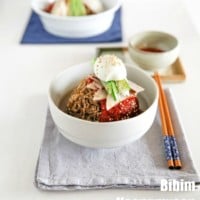
Bibim Naengmyeon (Korean Spicy Cold Noodles)
Ingredients
MAIN
- 350 g dried naengmyeon noodles (Korean buckwheat noodles)
- 150 g beef brisket (*see note above)
- 5 cups water (*see note above)
- 50 g Korean radish (or daikon, pink radish), thinly sliced or julienned
- 50 g Asian pear ( or Bosc pear) thinly sliced or julienned
- 60 g English cucumber (seeds removed, thinly sliced or julienned)
- 1 hard boiled egg (halved)
- 1 Tbsp toasted sesame seeds
- 1 dashA dash of roasted sesame seeds toasted sesame seeds
BIBIM SAUCE
- 20 g Asian pear
- 20 g brown onion
- 1/4 cup reserved beef broth (or water) from step 1 below (*see note above)
- 3 Tbsp Korean chili flakes (gochugaru)
- 2 Tbsp raw sugar
- 1 Tbsp toasted sesame seeds
- 1 Tbsp Korean chilli paste (gochujang)
- 1 Tbsp soy sauce
- 1 Tbsp apple cider vinegar
- 1 Tbsp minced garlic
- 1 tsp sesame oil
- 1 tsp fine sea salt
RADISH PICKLE SAUCE (MIX THESE TOGETHER AND MICROWAVE IT FOR 30 TO 40 SECONDS TO MELT THE SUGAR)
- 2 Tbsp white sugar
- 3 Tbsp apple cider vinegar
- 2 Tbsp water
Instructions
- Soak the brisket in a bowl of water and set aside for 20 mins to draw the blood out. Drain the water. Add the water (5 cups) and the brisket into a medium to large pot, cover with the lid and boil them over high heat. Skim off any scum that forms. Once the water starts to rolling boil, reduce the heat to low-medium. Simmer until the brisket is tender and cooked (I boiled them for 1 hour total. This should result in about 3 cups of broth.) Take out the meat onto a plate. Cool down the meat and the broth for 30 mins. Cut off any stringy fats and thinly slice the brisket.
- Soak the radish in the radish pickle sauce. Set aside until the radish is softened (about 20 mins). Cover and refrigerate until you need them. FYI, the longer you pickle, the less bitter the radish becomes.
- Combine all the bibim sauce ingredients and blend until pureed. Cover and refrigerate until needed.
- Cook the noodles in boiling water until soften (about 2 to 3 mins). Stir often during boiling. The noodle texture should be chewy and bouncy. Drain the water and rinse the noodles under cold running water a couple of times to cool down. Drain the water quickly and divide the noodle portion for serving. Place the mound of noodles into a serving bowl.
- Place the sliced beef, radish pickles, cucumber, pear and boiled egg on top of the noodles. Add the bibim sauce on top. Drizzle some sesame oil and sparingly sprinkle roasted sesame seeds. (Refer above pictures for decoration ideas.) Serve immediately.
Notes
Nutrition Info (per serving)
The nutrition information shown is an estimate provided by an online nutrition calculator. It should not be considered a substitute for a professional nutritionist’s advice.
